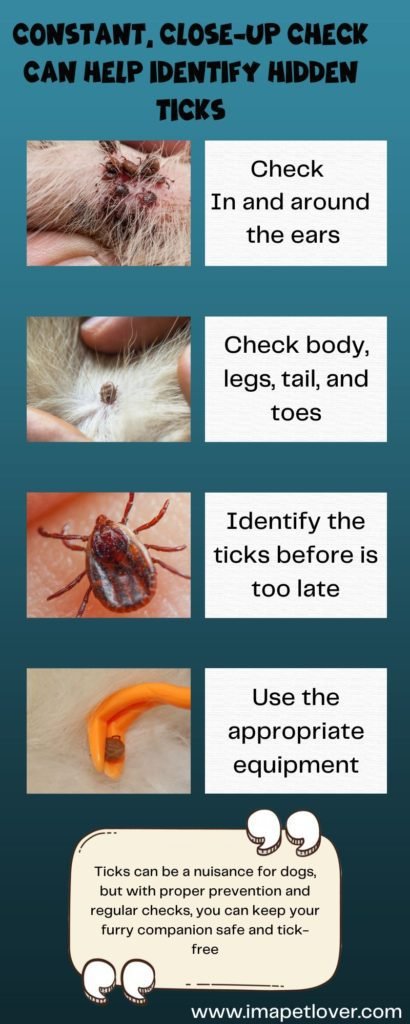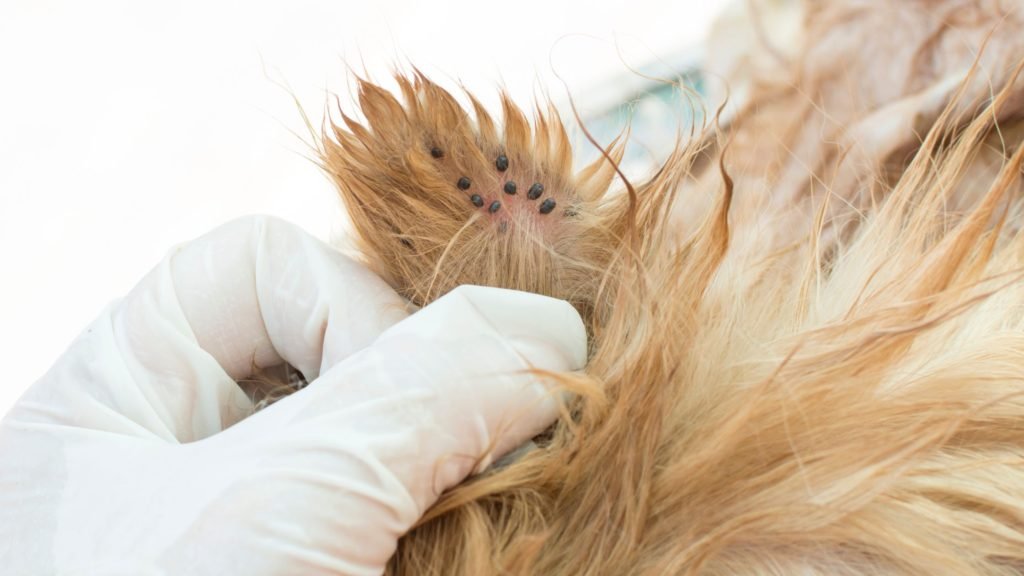Are you concerned about ticks on your dog? These tiny parasites can seriously threaten your hairy friend’s health, transmitting diseases that can be difficult to treat if not caught early. This article will cover everything you need to know about ticks on dogs, including how to prevent and treat tick bites and protect your dog from the dangers of tick-borne diseases. Don’t let ticks ruin your dog’s health – read on to learn more.

Types of Ticks That Affect Dogs
Several types of ticks can affect dogs, including:
- Deer ticks: These microscopic parasites, also known as black-legged ticks, are abundant in woodland and grassy regions and are known to spread Lyme disease to dogs.
- Brown dog ticks: These are found worldwide and can survive indoors, making them a particular concern for dogs who spend a lot of time inside.
- Lone star ticks: Distribution in the US is mainly restricted to the southeast. Ticks like this are known to spread illnesses like ehrlichiosis and anaplasmosis to dogs.
- American dog ticks: These ticks, which may be found across the United States, are known to spread Rocky Mountain spotted fever to dogs.
Symptoms of Tick Bites in Dogs
If a tick has bitten your dog, you may notice some or all of the following symptoms:
- Swelling or redness at the bite site
- Fever
- Loss of appetite
- Lethargy
- Difficulty breathing (in severe cases)
If you notice any of these symptoms in your dog, you must see a veterinarian as soon as possible. Sometimes, ticks can transmit serious diseases to dogs that can be difficult to treat if not caught early.
You may also interest: How to disinfect your dog after a walk
How to Prevent Tick Bites in Dogs
Preventive practices are the most effective strategy to protect your dog against tick bites. Among the alternatives are:
- Using preventative products: There are a variety of tick preventatives available for dogs, including tick collars, topical medications, and oral medications. Talk to your veterinarian about the best option for your dog.
- Regular grooming and checking for ticks: Grooming your dog regularly and checking for ticks can help to catch and remove any ticks that may have attached to your dog’s skin before they have a chance to transmit diseases.
- Avoid areas with high tick populations: Ticks are more abundant in forested and grassy regions, so avoid taking your dog there if possible.
- Using tick repellents in the home and yard: A variety of tick repellents are available in the house and yard to help keep ticks away from your dog.
How to Remove Ticks from Dogs
If you discover a tick on your dog, removing it as soon as possible is essential to reduce the risk of disease transmission. To remove a tick, use tweezers or a tick removal tool to gently grasp the tick near the head and pull it straight out. Avoid squeezing or crushing the tick, as this can release harmful fluids into your dog’s bloodstream.
Suggested Supplements
You may also interest: Dogs Irritated Skin: Expert Tips for Preventing and Treating
Treatment of Tick-Borne Diseases in Dogs
If your dog has been tick-bitten and is showing illness signs, take them to the doctor immediately. Your veterinarian can diagnose the cause of your dog’s symptoms and recommend appropriate treatment, including antibiotics and other medications.
Ticks can seriously threaten your dog’s health, but by taking preventive measures and promptly treating tick bites, you can help keep your furry friend healthy and happy. Be sure to use preventative products, groom your dog regularly, avoid areas with high tick populations, and use tick repe
Ticks on Dog's Ears

Ticks on a dog’s ears can be particularly concerning, as they can lead to ear infections and other health issues.
Symptoms:
Ticks on dogs’ ears can be difficult to detect, especially if your dog has long or floppy ears. However, there are a few signs that can indicate a tick infestation, including:
- Excessive head shaking or ear scratching.
- Redness, swelling, or inflammation around the ears
- Foul odor or discharge coming from the ears.
- Visible ticks or bite marks on the ear flap or inside the ear canal
Ear Cleaning:
If your dog has an ear infection due to ticks, your veterinarian may recommend ear cleaning to remove debris or discharge.
Remove Ticks Properly
Using fine-tipped tweezers, remove the tick by grasping it as close to the skin as possible and pulling it straight out with a steady motion. Be sure to clean the bite area with rubbing alcohol, soap, and water.
You may also interest: Effective Treatments for Dog Ear Infections
Ticks on Dogs on Summer
Summer is a great time to enjoy the outdoors with your furry companion, but unfortunately, it’s also peak tick season. Ticks may spread illnesses to dogs. Therefore, it’s crucial to prevent them in summer.
Here are some unique tips and tricks to keep your pup tick-free this summer:
Keep your lawn mowed and trimmed
Tall grass and overgrown vegetation provide the perfect breeding ground for ticks. Keep your lawn mowed and trimmed to reduce the chances of ticks latching onto your pup while they’re outside.
Create a tick-safe area
Consider creating a tick-safe zone if you have a designated play area for your dog in your yard. Cover the area with wood chips or mulch, which are less attractive to ticks, and place a fence to keep your dog from wandering into tick-infested areas.
Use tick-repelling plants
Some plants are natural tick repellents, such as lavender, lemongrass, and rosemary. Plant these in and around your yard to create a barrier between your pup and any nearby ticks.
Regularly groom your dog
Regular grooming not only helps to keep your dog’s coat healthy and shiny, but it also helps to catch any ticks before they have a chance to attach. Use a flea comb to run through your dog’s fur, paying close attention to areas like the ears, neck, and paws.
Use tick preventatives
Many tick-prevention products are on the market, including collars, sprays, and topical treatments. Please consult your veterinarian to determine the best tick prevention option for your furry friend, and apply it regularly.
Stay away from tick-infested areas
Avoid tick-infested regions when walking with your dog in the summer. Keep your dog on a leash and on well-maintained pathways to avoid tick-prone areas.
Following these tips can help keep your furry friend safe and healthy during summer. Even if you’re taking preventative measures, check your dog for ticks periodically and visit your vet if you suspect a bite. With a little effort and attention, you can enjoy the summer with your pup while avoiding the dangers of ticks.



